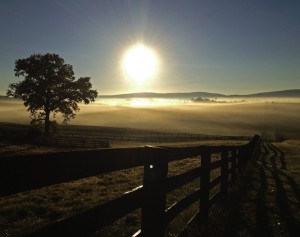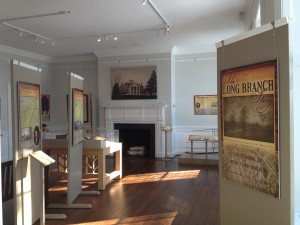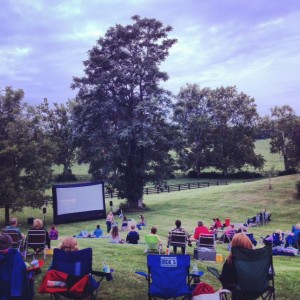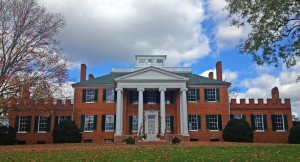Rethinking a local historic site
17 January 2014 – Cassie Ward

Long Branch’s fields once produced vast quantities of wheat. Today, these fields are home to a herd of retired horses. Photo credit: Cassie Ward
Every day I am asked, “You’re a public historian–what the heck is that and what do you do all day?” I smile from ear to ear, climb on top of my soapbox, and begin to talk about how fortunate I feel to have turned my love of history into a challenging and fulfilling career. I then begin to talk about the many great triumphs and challenges that I have experienced in my new position as the Director of Public Programs at Long Branch Plantation, a local Virginia historic site, located a little over an hour from Washington, DC. Long Branch, nestled in the shadow of the stunning Blue Ridge Mountains, preserves an over 200-year-old stately plantation home and nearly 400 acres of rural Virginia land.
In February 2013, I joined the small staff at Long Branch with the full understanding that the historic site was in the middle of a major year of transition and reorganization. While the site had operated as a museum for the past 20 years, the home’s furnishings and tours represented only a small chapter of Long Branch’s 200-year history–that of the last owner, Harry Z. Isaacs, the successful Baltimore textile executive who had performed a massive updating of the home in the 1980s. Isaacs purchased Long Branch with the intent of making it his full-time residence; sadly, however, he was diagnosed with terminal cancer and did not have the opportunity to live at Long Branch full time. Upon his death, Isaacs left Long Branch and a portion of his estate to a foundation he created to keep Long Branch open to the public for the community’s benefit and enjoyment.
Throughout the 1990s and early 2000s, Long Branch operated as a major event venue, becoming well known for its annual “Hot Air Balloon and Wine Festival,” and also as a classic historic house museum, with its once-and-done furniture tour. Lost in the site’s management and interpretation was Long Branch’s history as a wheat plantation and farm that dated back to the 1790s. For example, one family, the Nelsons, had owned the site for more than140 years. Where at the museum were the voices of the Nelson family or the subsequent families that called Long Branch their home? Where was the discussion of Long Branch’s history as a wheat plantation? Where were the voices of the enslaved workers who toiled in Long Branch’s fields and provided so much for its residents? What about the men of Long Branch who died during the Civil War? Or, the men and women who struggled to hold on to Long Branch as crops failed and financial crises took hold of the region? Did anyone speak of the many children who called Long Branch their home? The lack of historical interpretation was apparent–it was time to rectify the situation.
Strategic Planning

A large (severely altered) wing with very little historic integrity has been updated to serve as gallery/event/lecture/exhibit space. Photo credit: Cassie Ward
Under the leadership of Executive Director Nicholas Redding, Long Branch adopted a new strategic plan that will chart the course of the organization for the next five years. The plan provides Long Branch with guidelines to effectively manage the historic house museum (including its finances, interpretation, and preservation) and the site’s 400 acres of property. The lack of comprehensive historical interpretation that existed at the site is addressed in the plan. The solution was to begin exploring Long Branch’s full 200-year history; as a way to expand the interpretive themes and educational programming opportunities at the site.
With the official adoption of the strategic plan by the Long Branch Board of Directors in March 2013, it was go-time. We closed our doors for the 2013 Spring and Summer seasons and embarked upon the task of completely redoing everything about the way the house was run, marketed, and interpreted.
Hitting the Ground Running
To begin the process of turning Long Branch into a legitimate and respected historic site, the staff at Long Branch (including an amazing team of interns and contractors from as near as Shenandoah University to as far away as Finland), could be found doing any (and all) of the following over the past several months:
- Researching the history of the site at local and online archives to help establish Long Branch’s main periods of historical significance and to discover long-lost stories about Long Branch’s past residents. For more in-depth discussion on this, please see Nicholas Redding’s blog post: “What Year Would You Choose?”
- Assessing, preserving, and interpreting the historic space while at the same time creating new multi-functional gallery/exhibit/lecture spaces in rooms that exhibited no historic integrity
- Identifying and acquiring period furnishings that will enable visitors to tour the house by touching and interacting with history
- Rebranding the organization through a new website and logo
- Changing the site’s name from “Historic Long Branch,” to its actual historic name of Long Branch Plantation
- Reaching out and marketing to new audiences
- Designing exhibit panels and new site signage
- Performing grounds work to help maintain the beauty of the grounds
- Tending to the house’s maintenance issues (aka…this old house needs some TLC)
- Establishing ways to diversify our income stream
- Hosting events and planning weddings
- Drafting new programs and tours that excite visitors about local, regional, and national history

New programming at Long Branch includes an outdoor historic movies series. Moviegoers are provided with a brief history talk & a “Historian’s Toolbox Playbill.” Photo credit: Cassie Ward
With an organization that has a staff as small as ours, each member is required to “wear many hats.” Each staff member performs tasks generally associated with entire departments of people, which can seem daunting but feel rewarding.
It is our sincere hope that through all of these changes, we may establish Long Branch as a model historic house museum for the 21st century.
The Big Reveal and Community Response (to be continued)
While the entire strategic plan will take years to execute, a completed first phase of the plan was revealed to the public on October 25, 2013. With over 200 people present at Long Branch Plantation’s Grand Re-Opening night, we had the opportunity to receive a lot of community feedback on all of the site’s changes, big and small. If our opening weekend taught us anything, it is that visitors and community members are very interested in local history and are passionate about the cause. Please check back for a follow-up post about Long Branch’s efforts and challenges to re-establish the site as a valuable cultural resource within the local and regional community.
~ Cassie Ward is the Director of Public Programs at Long Branch Plantation in Virginia.





This is an excellent plan, I especially love the idea of putting things in the house that guests can touch. It allows people to break the museum taboo of touching and use senses besides sight. Additionally, this allows blind people or the visually impaired to experience the museum. Letting people touch objects opens a whole new world of interaction and experience for all guests.
It sounds like Long Branch Plantation needed a serious facelift in its history, exhibits, and programming. However, every conference and lecture I attend discusses the fact that the house museum business model is no longer viable. There are simply too many of them in the US and their appeal is fading. How does Long Branch plan to differentiate itself from other house museums? What will give it that special something to appeal to a broader audience?